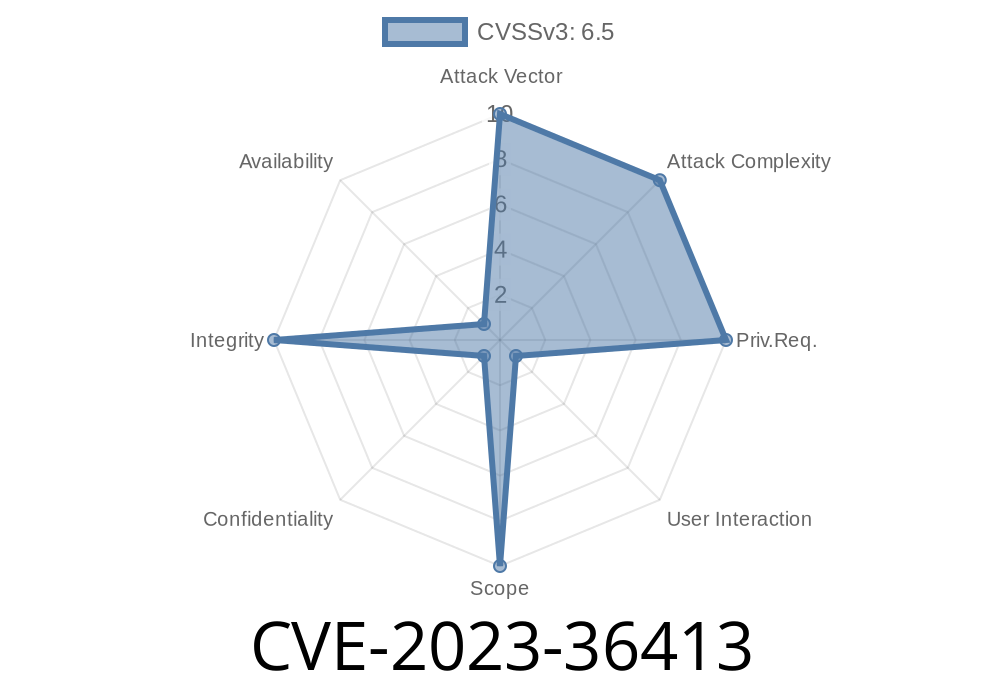CVE-2023-36413 is an identified vulnerability in Microsoft Office that potentially allows attackers to bypass security features by exploiting a weak point in the application. This vulnerability has the potential to impact millions of users worldwide who rely on Microsoft Office for their day-to-day work. In this comprehensive post, we will explore the details of this exploit, including code snippets, links to original references, and best practices for mitigating this risk.
Understanding CVE-2023-36413
CVE-2023-36413 is classified as a security feature bypass vulnerability that affects Microsoft Office. This exploit enables attackers to circumvent the software's built-in security measures and gain unauthorized access to sensitive data and resources.
This vulnerability is caused by the improper handling of certain document formats or memory manipulation within the Office software. The following code snippet demonstrates a simplified scenario highlighting the issue:
// Vulnerable code snippet
void process_document(Document* doc) {
uint8_t* buffer;
uint32_t data_size;
// Read the data size from the document
data_size = get_data_size(doc);
buffer = (uint8_t*)malloc(data_size);
// Load the document into the buffer
read_data(doc, buffer, data_size);
// Process the document
process_buffer(buffer, data_size);
// Clean up and finish
free(buffer);
}
In this example, an attacker could exploit the vulnerability by injecting malicious payloads into a document's contents or manipulating its memory buffers.
Original References and Additional Resources
To better understand CVE-2023-36413, one should refer to official sources and documents. Here are some essential links:
1. CVE-2023-36413: National Vulnerability Database (NVD) Entry
2. Microsoft Security Advisory
3. Microsoft Security Response Center (MSRC) Blog
4. Vulnerability Analysis by Trend Micro
Exploit Details
To exploit this vulnerability, an attacker needs to craft a malicious document and deceive the user into opening it. Once the user opens the document, the attacker's code gets executed with the security context of the targeted user. Depending on the victim's rights, the attacker can gain unauthorized access to sensitive data and resources or execute additional malicious code on the target system.
Mitigation and Best Practices
In order to mitigate this vulnerability and protect your systems, it is recommended to follow these best practices:
1. Keep your Microsoft Office applications up-to-date with the latest security patches. For CVE-2023-36413, ensure you have the most recent update installed.
2. Employ a trusted, multi-layered security solution that scans your email attachments and documents for potential threats.
3. Ensure your operating system and other software applications are also updated with the latest security patches.
4. Educate users about the dangers of opening unknown or unsolicited documents, as these can contain malicious payloads.
5. Create and enforce user policies that restrict running unknown scripts or macros in Microsoft Office applications.
In conclusion, while the CVE-2023-36413 vulnerability can pose a dangerous threat to Microsoft Office users, staying informed of the vulnerability's details and employing proper security measures can significantly reduce the risks associated with this exploit. Remember to keep your software up-to-date and practice good cybersecurity hygiene to ensure your system is well-protected from potential threats.
Timeline
Published on: 11/14/2023 18:15:44 UTC
Last modified on: 11/20/2023 20:19:01 UTC
